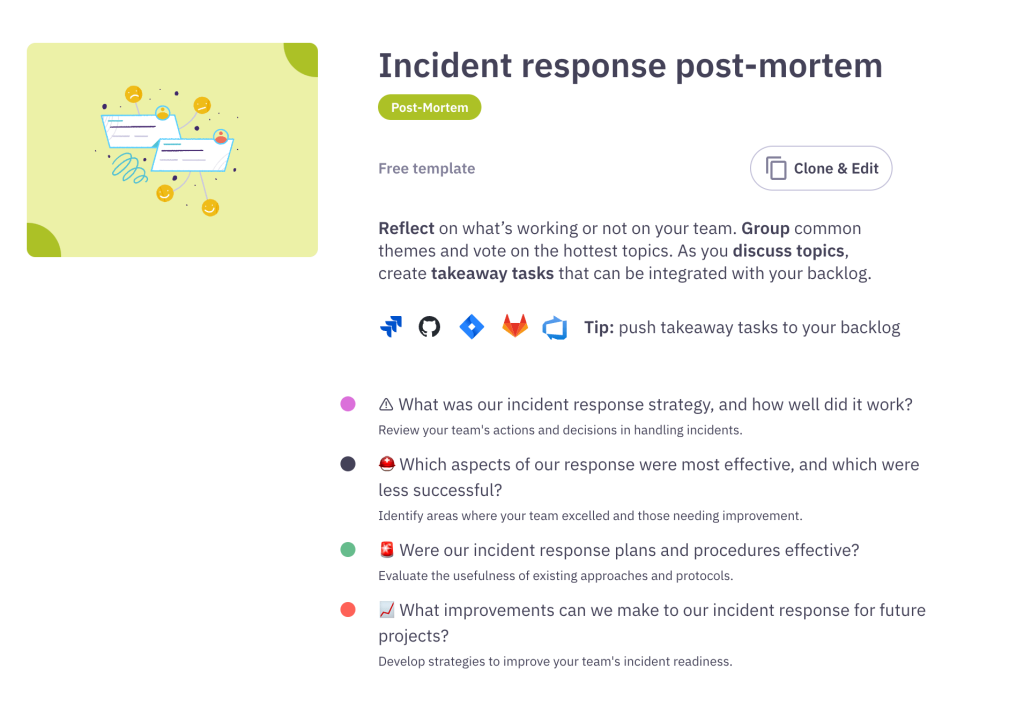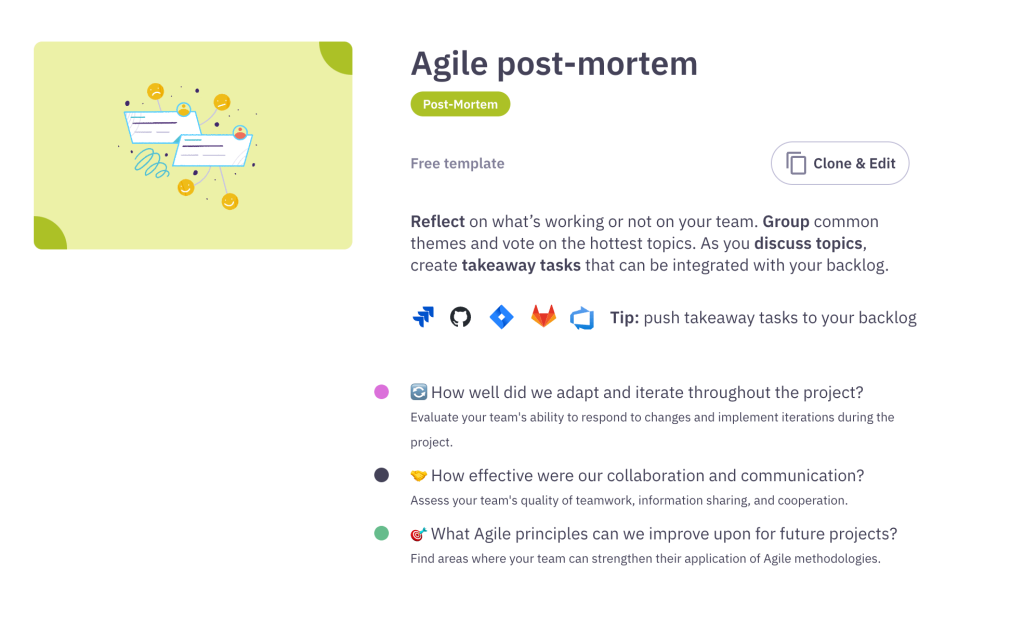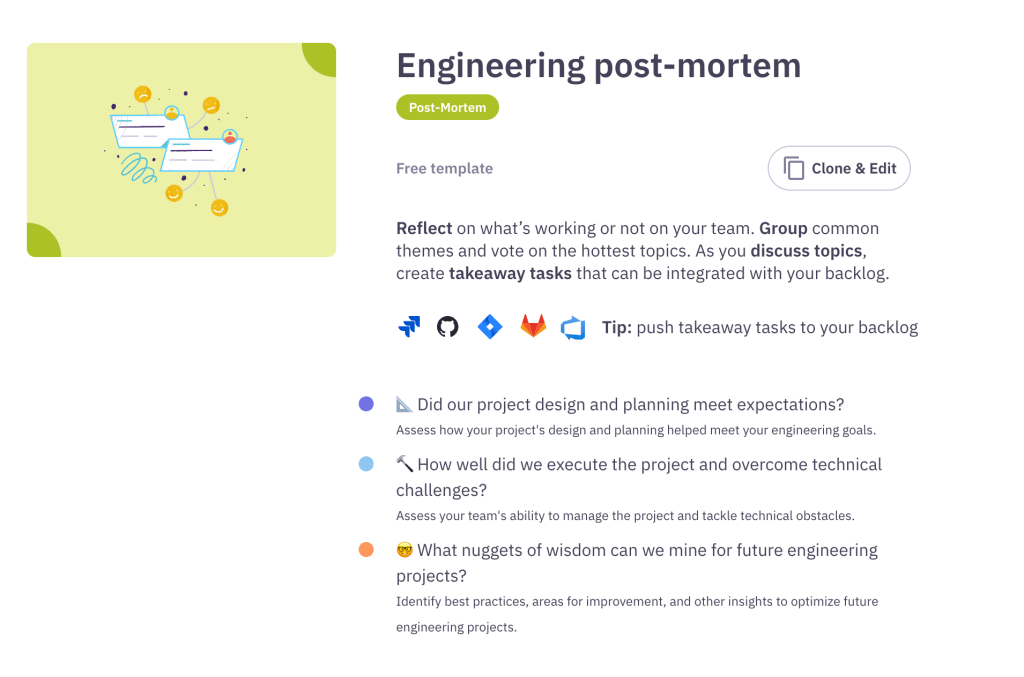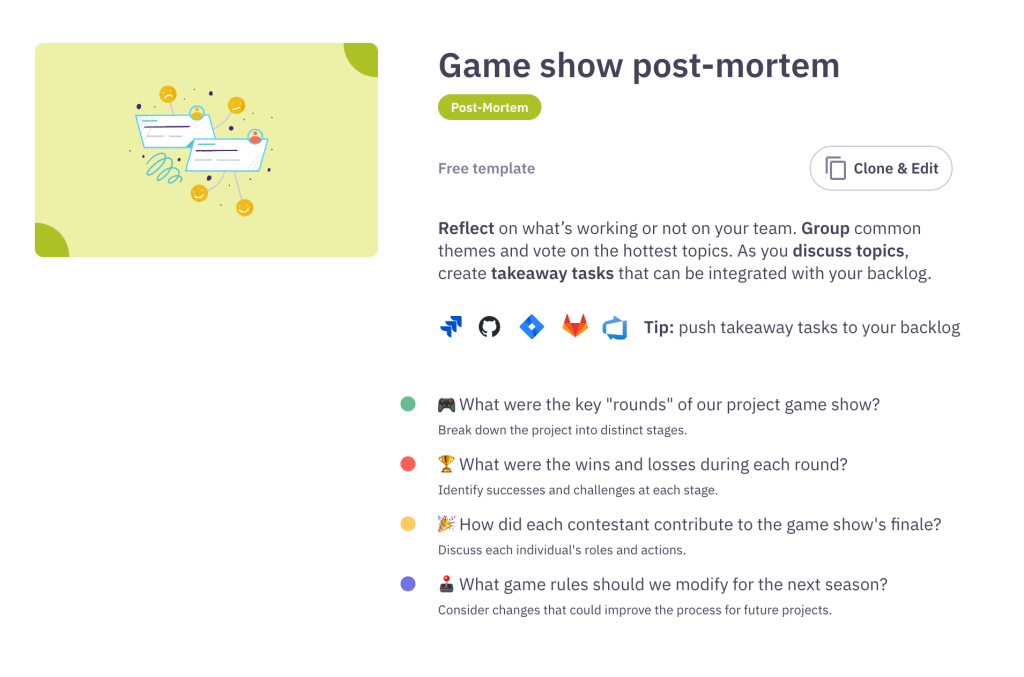How to Run a Post-Mortem Meeting: Easy 6-Step Process

Every failed project contains seeds for future success. But too many teams leave these lessons buried because they don’t take the time to unearth them.
A post-mortem meeting is your team’s shovel – a tool for uncovering these insights. Post-mortems are an opportunity to come together, dig deep into a project or incident, and determine what went wrong. The process isn’t a blame game but a way to learn, grow, and turn hindsight into foresight.
By the end of this article, you’ll know exactly how to run a productive post-mortem with your team. We’ll cover the following topics:
What is a post-mortem meeting?
A post-mortem meeting is a team workshop for reflecting on a failed project or significant incident. Unlike its counterpart, the pre-mortem meeting, which anticipates potential problems before they occur, a post-mortem meeting happens after the fact.
During a post-mortem, your team examines the events leading to an incident or project failure, much like a coroner doing an autopsy. The goal is to find the root causes of issues, learn from them, and develop strategies to prevent similar problems in the future.
When to run a post-mortem meeting?
Projects, like people, only have post-mortems when something has gone horribly wrong. You can learn how to prevent similar problems by understanding a project failure or incident.
You should consider holding post-mortems meetings in the following situations:
- After a project failure or critical issue. When a project doesn’t achieve its goals or faces a big blocker that slows progress, a post-mortem meeting helps get to the root causes of such problems.
- Following a significant incident or outage. After a big problem like a server crash or an app outage, a post-mortem meeting lets you figure out what went wrong and define actions to prevent future incidents.
- When a client relationship ends unexpectedly. A post-mortem meeting can provide insights into why a customer left so you can improve other client relationships and your retention strategies.
- If the cost of failure was high. When failure results in substantial financial, reputational, or operational costs, a post-mortem meeting helps understand the impact and how to ensure such costly failures don’t happen again.
- After reaching a significant project milestone. Conducting post-mortem meetings after key milestones of larger projects helps catch minor issues before they become major problems.
What are the benefits of a post-mortem meeting?
Post-mortems are an invaluable tool for practicing continuous improvement within your team or organization. Here are the meeting’s biggest benefits.
1. Thorough understanding of root causes
By analyzing the events, actions, and decisions that led to a failure, problem, or incident, your team can identify the root causes of issues instead of just addressing symptoms.
For example, if a software release introduced a bug that caused system downtime, rather than simply fixing the bug, a post-mortem meeting could identify the root cause as insufficient testing protocols. Without this understanding, similar bugs could appear in future releases.
2. Enhanced team collaboration and learning
Every failure carries valuable lessons. Since post-mortem meetings are collaborative, they allow team members to share their perspectives and insights about a project or incident. This process creates a culture of transparency, mutual respect, and shared learning. Sharing openly can also improve psychological safety.
3. Stronger ownership of problems
A post-mortem meeting’s collective approach to problem-solving instills a sense of ownership among team members. When everyone shares responsibility for finding solutions, your team is more likely to see through these initiatives.
4. Optimized decision-making and project planning
Insights from a post-mortem can improve your team’s decision-making process. By understanding what went wrong, why, and how, your team can make more informed decisions in the future.
5. Habitual continuous improvement
By consistently learning from failures through post-mortem meetings, your team creates a habit of self-assessment and learning. Such continuous improvement leads to a proactive, adaptive mindset that drives success across all your projects and initiatives.
How to conduct a post-mortem meeting?
Setting the rules and scene at the beginning of the meeting creates a positive and productive environment for your post-mortem discussion. Here are some guidelines to ensure a smooth discussion:
1. Set the rules and scene
Setting the rules and scene at the beginning of the meeting creates a positive and productive environment for your post-mortem discussion. Here are some guidelines to ensure a smooth discussion:
- Focus on the situation, not individuals. Encourage participants to focus on the events, decisions, and processes that led to the project outcome rather than on the actions of specific individuals.
- Promote open and respectful discussion. Ensure all participants feel respected and heard. Everyone’s input is valuable, and different viewpoints help paint a more complete picture of what happened.
- Emphasize learning and improvement. The primary goal of a post-mortem is learning from a project and using these insights for future improvements. Remember this goal throughout the meeting, and steer the conversation towards identifying lessons learned and solutions.
2. Choose a project post-mortem template
Post-mortems often fail to deliver results when they lack structure, making it difficult for team members to contribute effectively or define follow-up action items.
A well-structured template or agenda organizes the meeting in clear phases and provides prompts your team can respond to.
The easiest way to start following such a structure is with Parabol’s pre-built templates for different project types and scenarios. These templates provide a framework for your meeting, guiding your team through the analysis step by step.
To start your post-mortem meeting in Parabol, click the button below, navigate to “retrospectives,” and choose one of the post-mortem templates.
3. Reflect on what went wrong
Ask your team to note down reflections according to the prompts in your template. You may consider reflecting on what went wrong, why something went wrong, any early warning signs of what was going wrong, or even how to prevent issues recurring in future.
Parabol offers a way for all team members to easily reflect on these questions with anonymous responses to preserve psychological safety.
4. Group failures into themes
Grouping problems into themes can provide a higher-level view of patterns and recurring issues within your projects or incidents. It’s not uncommon to discover a common thread between seemingly unrelated issues.
For example, consider a situation where one issue happened because of misunderstandings in email communication, another due to a lack of clarity during team meetings, and a third because of problems with your project management tools. Each problem could be a root cause in the previous step, but grouping them reveals a more systematic issue of “communication breakdown.”
You can group failures into themes in a few simple steps:
- Review all identified issues. Read out all the root causes from the previous step.
- Identify commonalities. Look for commonalities between the problems, like similar causes, effects, or other factors.
- Create theme groups. Create groups or “themes” of failures based on the identified commonalities.
- Refine groups. Review your groups and make sure they accurately represent the failures. If necessary, create new groups, merge existing ones, or move issues between them.
It’s ok if some reflections don’t fit into any group. The goal is finding patterns and common themes to guide your next steps.
In Parabol, your team can easily group issues in real-time through a multiplayer drag-and-drop interface. The tool can even automatically group like-minded reflections together, giving you a head-start and saving more time for your discussion.
5. Prioritize topics by voting on them
Ask team members to vote on which themes they think are the most significant or likely to have caused the project to fail. As a facilitator, you can guide team members to base their votes on the likelihood of occurrence, the magnitude of the issue, or both.
In Parabol, the facilitator can set how many votes each team member gets.
We recommend giving each team member six votes and suggest voting in a 3-2-1 pattern. The most critical issue to a team member gets a three, the second a two, and the third a one. This approach results in more precise prioritization, which can be valuable when the team needs to decide where to focus their improvement efforts first.
When everyone has voted, and you reveal the outcome, you should have a prioritized agenda of discussion topics for the next step.
6. Discuss and set action items
After finding the most critical issues through voting, tackle them one-by-one to come up with preventive solutions. This step is crucial for turning insights into lessons and actions.
Encourage team members to suggest solutions for each of the prioritized issues. Your goal is to generate as many ideas as possible. Parabol includes a discussion thread to keep track of suggestions or drop in thoughts via text if it’s hard to get a word in.
Remember to create an action plan and follow-up tasks as you work through each theme. With Parabol, you can do this directly in the meeting and export those items to a task management tool like Jira or GitHub.
What happens next?
The goal of a post-mortem is not just to identify what went wrong but to ensure you don’t repeat the same mistakes in the future—real value comes from the actions you take after the meeting.
Once you finish your post-mortem meeting, Parabol automatically sends a summary to everyone, including an overview of follow-up actions. Here’s how you can make sure the team completes these tasks:
- Monitor progress. Regularly check the progress of the action items. You can do this during regular team meetings or a dedicated follow-up session.
- Share the knowledge. Share the findings and lessons learned with the rest of the organization to promote a learning culture and continuous improvement.
- Review in future meetings. In your future post-mortems, review the action items from previous meetings to ensure closure.
Alternative Post-Mortem Methods
Here are a few alternative methods for running a post-mortem meeting that may suit your needs.You can add these steps as part of the approach documented above, or run these as standalone exercises.
Review the timeline of events
Create a detailed timeline of the project or incident. Include all events, decisions, and actions, even those that may seem insignificant. This comprehensive review helps you understand the sequence of actions and decisions that led to the undesired outcome.
As you review the timeline, encourage everyone on the team to share their perspectives and experiences. Different team members may have different thoughts on what happened and why. These diverse viewpoints provide valuable insights you can use to analyze the root causes of a problem during the next step.
Analyze the root cause
In this step, you’ll dig deep into each problem and ask “why” it happened. You can use a model like “5 Whys” to help get to the bottom of issues.
The 5 Whys technique involves asking “why” five times, or as many times as needed, to get to the root cause of a problem. For example, if a project missed its deadline, you might ask:
- Why did the project miss its deadline? The project took longer than expected.
- Why did the project take longer than expected? There were unexpected technical challenges.
- Why were there unexpected technical challenges? The team didn’t have the necessary technical skills.
- Why didn’t the team have the required technical skills? The team wasn’t properly trained.
- Why wasn’t the team properly trained? There was no budget for training.
By the end of this process, you’ve identified the root cause of the problem (”lack of budget for training” in this case), which you can then address to prevent similar issues in the future.
Another helpful tool for root cause analysis is the Fishbone Diagram, also known as the Ishikawa Diagram or Cause and Effect Diagram. This tool helps you visualize the many potential causes of a problem, making it easier to identify the root cause.
Post-mortem templates
You should pick a post-mortem template for your meeting depending on the issues you’re reviewing and what’s appropriate for your team. Here are four examples from 22 Post-Mortem Templates For Your Next Workshop. Parabol includes all of these post-mortem templates for you to try for free! Here are a handful of popular post-mortem templates.
Incident response post-mortem template

The incident response post-mortem reveals an incident’s root causes and contributing factors. You can use this understanding to create tailored strategies and follow-up actions for each problem you experience and ensure they never happen again.
Agile post-mortem template

The Agile post-mortem tests your team’s commitment to Agile principles such as adaptability, iteration, and collaboration. This template helps unlock your team’s potential for continuous improvement and reinforces the spirit of Agile in every project, leading to better teamwork and adaptability.
Engineering post-mortem template

The engineering post-mortem enables your team to appraise the project’s design, execution, and technical challenges. This template creates a roadmap for engineering excellence, guiding future projects toward success.
Game show post-mortem

The game show post-mortem transforms your project review into an interactive game show. This innovative format keeps your team active and involved, making the analysis more engaging and entertaining.
Post-mortem questions for facilitators
Effective questions from a meeting facilitator can trigger new perspectives and unique insights from team members during a post-mortem. Here are several helpful prompts from 50+ Post-Mortem Questions To Help You Learn From Failure:
- What were the project goals, and in what ways did we fail to meet them?
- What were the strengths and weaknesses of the project?
- What steps did we take to try to prevent the problem?
- Were there any significant risks we failed to identify before the project began?
- Did we encounter any technical issues, and how were they resolved?
- Were there any factors beyond our control that contributed to the problem?
- Were there any warning signs that we missed?
- Was the incident well-documented, and can it be replicated?
- Did we have the right processes and procedures to handle issues arising from the project?
Post-mortem survey questions
A post-mortem survey can be an effective way to gather additional insights from team members after the meeting. It allows individuals to provide more detailed feedback and identify areas that didn’t get enough attention during the meeting.
Here are some questions that require more reflection, which makes them ideal for a post-mortem survey:
- What was the biggest challenge faced during the project?
- Did we have the right resources to complete the project?
- What was the overall team dynamic, and did everyone work well together?
- How did we adapt our approach when things were going wrong?
- Were there any significant risks we failed to identify before the project began?
- Did the team identify any new opportunities or insights during the project?
- Were the roles and responsibilities of team members clear and well-defined?
- Did we follow best practices to mitigate and deal with setbacks or issues?
- Did we encounter any unexpected obstacles or problems, and how were they resolved?
- Did we gather and analyze enough data during the project?
- Were there any dependencies that were not adequately addressed?
Turn hindsight into foresight with a post-mortem
By conducting post-mortem meetings, you’re not just addressing the issues of the past; you’re also shaping the future. You’re equipping your team with the knowledge and strategies they need to avoid similar pitfalls and improve future projects.
So don’t let the past hold you back. Learn from it, grow from it, and use it to shape a better future. Start running your post-mortem meetings today with Parabol and turn every failure into a stepping stone toward success.
Post-mortem meeting FAQs
What’s the exact meaning of “post-mortem meeting”?
A post-mortem meeting is a discussion after a project or incident to analyze its successes and failures. The term “post-mortem” is Latin for “after death” and, in this context, refers to a thorough examination after the “death” or end of a project. The objective is to identify what went well, what went wrong, and how to improve for future projects.
Do you have a post-mortem checklist?
Yes, a post-mortem checklist can be a valuable tool to ensure thorough and productive meetings. Here’s a basic checklist to get you started:
- Invite all relevant stakeholders to the meeting.
- Establish a safe and open environment for discussion.
- Reflect on what went wrong or what caused the failure.
- Group failures into themes.
- Prioritize topics by voting on them.
- Discuss and develop strategies for improvement.
- Assign responsibilities for implementing these strategies.
- Follow up on action items after the meeting.
- Document and share the findings with the wider team or organization.
What is a project post-mortem report?
A project post-mortem report serves as a comprehensive document that captures the findings from the post-mortem meeting. It provides a detailed account of the project’s performance, including the goals achieved, the challenges faced, and the lessons learned.
The report identifies the root causes of any issues and suggests actions to prevent similar problems in the future. The primary objective of this report is to share these valuable insights and learnings across an organization, creating a culture of continuous improvement and collective growth.






